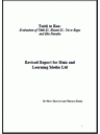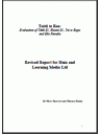This evaluative study, Toitū te Reo: Evaluation of Tāiki E!, Haumi E!, Toi te Kupu and Eke Panuku, provides a critical evaluation for the Ministry of Education of student materials used in the Māori medium sector. Educational materials that validate Māori identity, tikanga and te reo Māori, and that accurately and positively reflect the readers’ lives and values through text and images are an important part of the educational experience for Māori students. Equally, any study of those educational experiences, inclusive of materials produced to support learning and teaching in the Māori medium context, will be best achieved by researchers who are themselves positioned within the community being researched. Only then can Māori-centred research projects satisfy the research demands of kaupapa Māori education, because the research is positioned within the community and is accountable to community – kura, whānau, hapū and iwi. This is a Māori-centred research approach that produces findings that are relevant and meaningful with a view to improved reo Māori outcomes for ākonga.
This report provides a summary and clarification of the issues identified by the research participants and literature in relation to the development of Māori language resources. It has three main sections. The first section describes the structure of the project, the research methodology which guided this project and further relevant literature which contextualises the study.
The second section focuses on the questions which this study sought to answer and discusses the issues raised by the research participants. A range of strategies to address those issues are suggested in the discussions, including areas for further research and development.
The third section, te pūmanawa o te whakaaro, te kiko o te kaupapa, is an exposé of the data integrated into the relevant sections. These are included as appendices (see Appendix 2-6).


